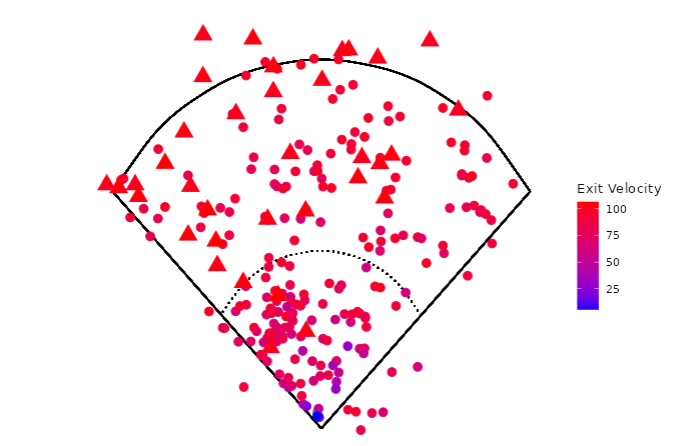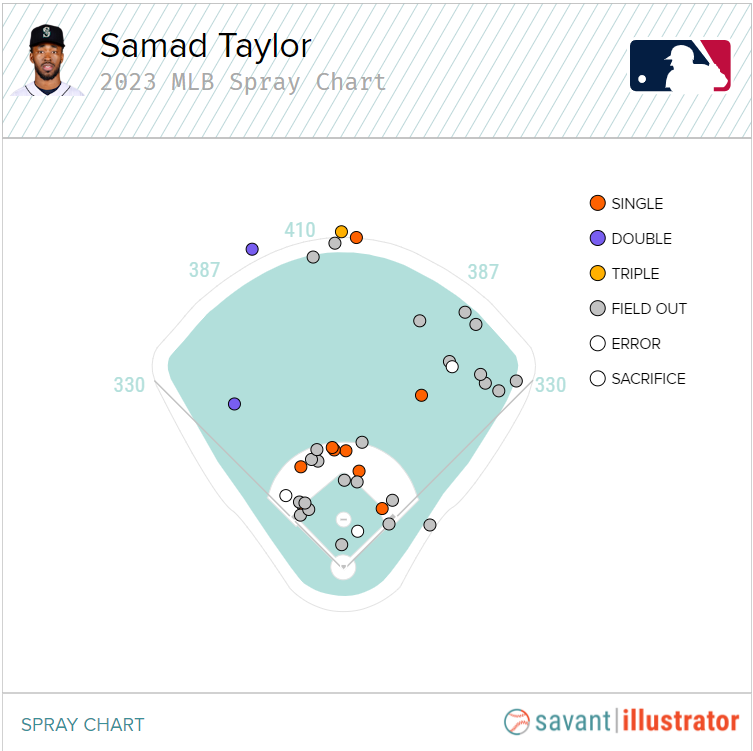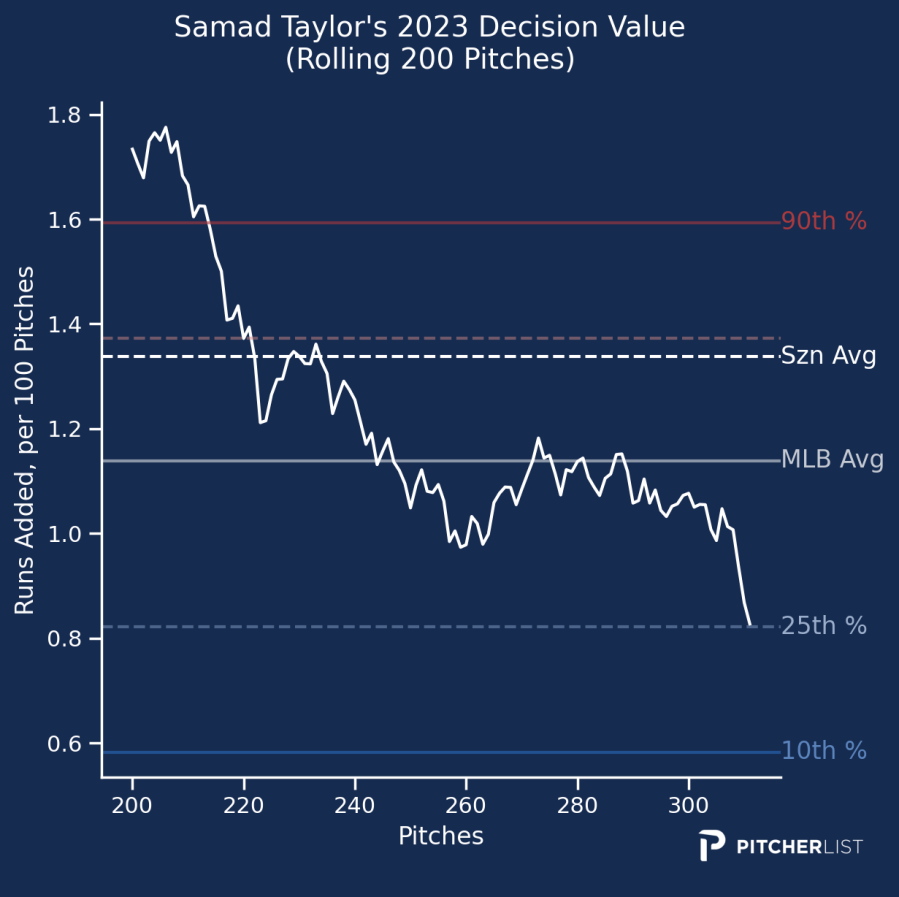The Royals made the Adam Frazier signing official on Monday afternoon, announcing that they signed him to a one-year deal with a mutual option for 2025.
Frazier spoke to the media for the first time on Tuesday and it seems clear that he will have to compete for playing time in 2024 with the Royals.
In Picollo’s interview with 810 AM radio, he mentioned that they want Frazier to have a flexible role in terms of position, which should calm the fears of Royals fans thinking that Michael Massey would automatically lose the keystone position after the Frazier acquisition.
Even though Frazier’s role is still to be determined in Kansas City for the upcoming season, it appears that the Royals’ spending spree this offseason and the organization’s reputation were both primary reasons why Frazier decided to sign a deal with the Royals this offseason.
To make room for Frazier on the 40-man roster, the Royals traded away 2B/OF Samad Taylor to the Seattle Mariners in a deal that involved cash considerations and a player to be named later. Both the Royals’ and Mariners’ social media accounts announced the deal.
The move made sense considering that Frazier will likely fill a utility role in the infield and outfield that Taylor would’ve been competing for in Spring Training. In addition to Frazier, Nick Loftin, Devin Mann, Mike Brousseau, Cam Devanney, and Tyler Tolbert are all non-roster invitees who share the same kind of position versatility as Taylor and are trying to compete for that bench utility role. Therefore, it made sense for the Royals to trade from an area of depth in their organization to make space for Frazier.
That said, the move was a bit polarizing among Royals fans.
It especially enticed those fans who are not only unhappy that the Royals are getting a bit older on the position-player end, but also signing players who could be taking at-bats away from players who could be part of the Royals’ long-term future.
I understand the initial frustration, especially considering that Taylor posted a .301/.418/.466 slash with a 128 wRC+, 8 home runs, and 43 stolen bases in 414 plate appearances with the Storm Chasers last season. On the other hand, Taylor looked overwhelmed in his first experience at the Major League level.
In 31 games and 69 plate appearances, Taylor slashed .200/.279/.267 with a 49 wRC+ and 8 stolen bases. His K% jumped from 20.5% in Triple-A to 31.9% in the Majors and consequently, his BB/K ratio also regressed from 0.78 in Omaha to 0.32 in Kansas City. While it is a small sample, his brief MLB debut with the Royals in 2023 didn’t exactly cement a guaranteed spot on the active or even 40-man roster this spring.
Nonetheless, did the Royals make a mistake with Taylor? Should they have kept him around longer, even if he may have begun the years in Omaha?
Let’s take a look at the challenges with Taylor and the Royals’ roster situation for this upcoming season, and why the Taylor move makes sense for the Royals in both the short and long term.
Taylor’s Triple-A Statcast Metrics Were Suspect
The surface-level Omaha numbers from Taylor look impressive. However, one concern that stuck out was his .373 BABIP, which is pretty high even for Werner Park (it profiles as a hitter-friendly park according to Minor League park factors).
Did Taylor have a high BABIP because he was scorching the ball consistently? Or was he benefiting from some favorable park conditions and batted-ball luck?
Unfortunately, it may be the latter, especially when looking at his Triple-A Statcast data via the Prospects Live AAA Statcast app.
Here is a look at Taylor’s Statcast metrics with the Storm Chasers compared to fellow utility Storm Chaser players such as Mann, Loftin, and Nate Eaton (Mann’s numbers are combined from his time in Oklahoma City in the Dodgers organization).
As Royals fans can see, when it comes to batted-ball quality, Taylor ranks near the bottom of this group of four in most categories. That includes average exit velocity (84.7 MPH), Hard-Hit% (27.2%), and Barrel% (5.5%).
Granted, Taylor showed a more disciplined approach compared to the other three hitters (he sported the lowest Swing% and second-lowest O-Swing%). However, it wasn’t enough for Taylor to overcome his deficiencies in his other Triple-A Statcast metrics, which eventually affected him at the Major League level.
That was especially true in the difference between his MiLB EV Spray Chart and his MLB Batted Ball Spray Chart. Even though Taylor’s batted ball direction didn’t change much in his promotion, his batted balls with the Royals resulted in a lot more outs, which can be seen below.


Of course, it is a much smaller sample size for Taylor at the MLB level. Royals fans have to wonder if he would’ve been able to pull the ball more at the MLB level with more exposure to MLB pitching. He had a lot of hard-hit balls up the middle in Omaha that just didn’t transition to his time in Kansas City.
Then again though, his Decision Value PLV rolling chart showcased a pretty discouraging trend in his swing and take decisions as he saw more plate appearances with the Royals in his MLB debut last year.

Based on the combination of Statcast metrics and concerning Decision Value trends at the Major League level, I think the Royals were justified in their decision to part ways with Taylor to make room for the newly acquired Frazier.
The Problem With Using ZiPS to Compare Taylor and Frazier
One of the biggest arguments Royals fans have used when defending Taylor over Frazier has been the fact that ZiPS is projecting Taylor to have a “slightly” better season than Frazier.
I dislike comparing Taylor and Frazier by ZiPS just straight up for a variety of reasons.
One of my main concerns with utilizing comparisons using ZiPS in this fashion is that Taylor and Frazier are both at different points in their careers. Taylor has only played in 31 MLB games. Frazier has played in 962 games. Thus, we know what kind of player type Frazier is, while we don’t really have an idea about Taylor’s player type just yet.
This is important because when it comes to making projections, ZiPS uses growth and decline curves based on player type. Frazier’s type is pretty well-known at this point because he has played in so many games. Taylor doesn’t have that game total just yet. Because of that lack of clarity in player-type comparison, players who don’t have much of an MLB resume just yet, like Taylor, tend to have more optimistic projections.
Don’t believe me?
In 2022, Nick Pratto, who hadn’t played an MLB game to that point, had a ZiPS projection of 2.0. That projection dipped to 0.7 in 2023 after getting 182 plate appearances in 2022. Also in 2023, catcher Jackson Reetz had a ZiPS projection of 1.2. Reetz didn’t play at all at the Major League level last year.
It’d be one thing if Taylor and Frazier were at similar points in their careers. But comparing the ZiPS of a veteran who is 32 years old to a 26-year-old rookie isn’t a fair comparison.
If anything, it’s more likely that Frazier would meet his modest projection than Taylor, who generated a -0.1 fWAR in 2023 (compared to Frazier’s 0.3 fWAR).
Taylor Was Going to Have Difficulty Holding Onto His Roster Spot After 2024
A big issue for Taylor long-term was that he had some competition at second base coming up the pipeline this year.
Peyton Wilson is one of those promising prospects who can play the keystone position. The former Crimson Tide product played in the Arizona Fall League this past fall and hit .286 with a 108 wRC+ in 562 plate appearances with the Naturals last year. He also collected six home runs and stole 19 bases in Northwest Arkansas as well and is likely to improve upon those numbers in Omaha in 2024.
Wilson would need to be added to the 40-man roster at some point in 2024 to be protected from the Rule 5 Draft next winter. Thus, if Taylor didn’t make significant progress this spring in Cactus League play or in Omaha, he likely would’ve been designated for assignment by the end of the 2024 season to make room for Wilson.
Javier Vaz is another infielder with some outfield capability like Taylor who had a solid season in High-A and Double-A last year and could matriculate his way to Triple-A at some point in 2024. Vaz’s numbers in High-A and Double-A are perhaps just as good, if not better, than Taylor’s.
Thus, the Royals may have valued Vaz’s versatility and outlook more and probably preferred too that he had more years of control than Taylor as well. It’s hard to imagine this Royals 40-man roster containing both Taylor and Vaz in Spring Training of 2025. They are just too similar profile-wise.
These are the kinds of tough decisions that the Royals were facing with Taylor, and it was probably good for JJ Picollo and the Royals front office to see this on the horizon and make that tough move to deal with Taylor now for something in return rather than just DFA him and release him for nothing.
Maybe Taylor proves me and other naysayers wrong…
However, the Royals shouldn’t stunt or block the development of guys like Wilson and Vaz just to see if Taylor can be a possible “utility” guy at the MLB level in 2024 and 2025.
Photo Credit: Ed Zurga/GettyImages

[…] O’Brein at The Royals Reporter: Samad Taylor And the Challenges of His Roster Situation With the Royals (prior to the […]
LikeLike